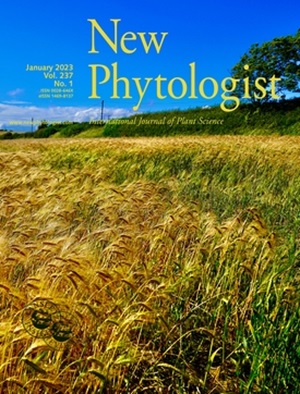Genetic variation in a tandemly duplicated TPS gene cluster contributes to the diversity of aroma in lychee fruit
IF 8.3
1区 生物学
Q1 PLANT SCIENCES
引用次数: 0
Abstract
- Fruits undergo a similar ripening process, yet they exhibit a range of differences in color, taste, and shape, both across different species and within the same species. How does this diversity arise? We uncovered a conserved fruit ripening process in lychee fruit in which a NAC transcription factor, LcNAC1, acts as a master regulator. LcNAC1 regulates the expression of two terpene synthase genes, LcTPSa1 and LcTPSa2, which belong to a gene cluster consisting of four TPS genes. LcTPSa1–LcTPSa3 are responsible for catalyzing the production of farnesol, which in turn dictates the aromatic diversity in fruit of different lychee varieties.
- Through comparative, transcriptomic, and genomic analyses across various lychee varieties, we found these four TPS genes exhibit distinct expression levels due to natural genetic variation. These include copy number variations, presence/absence variations, insertions and deletions, and single nucleotide polymorphisms, many of which affect the binding affinity of LcNAC1.
- A single nucleotide mutation in LcTPSa1 caused a premature translational termination, resulting in a truncated version of the TPS protein, which surprisingly remains functional.
- All these genomic changes in the LcNAC1-regulated TPS genes are likely to contribute to the great aromatic diversity observed in lychee fruit. This diversification of fruit aroma in lychee varieties offers a compelling example of how species- or variety-specific traits evolve – the phenotypic diversity is primarily derived from natural genetic variation accumulated in downstream structural genes within an evolutionarily conserved regulatory circuit.
TPS基因簇的遗传变异是荔枝果实香气多样性的重要组成部分
水果经历了类似的成熟过程,但它们在颜色、味道和形状上表现出一系列差异,无论是在不同物种之间还是在同一物种内。这种多样性是如何产生的?我们在荔枝果实中发现了一个保守的果实成熟过程,其中NAC转录因子LcNAC1起着主调控作用。LcNAC1调控两个萜烯合成酶基因LcTPSa1和LcTPSa2的表达,这两个基因属于一个由四个TPS基因组成的基因簇。LcTPSa1-LcTPSa3负责催化法尼醇的产生,这反过来决定了不同荔枝品种果实的芳香多样性。通过对不同荔枝品种的比较、转录组学和基因组分析,我们发现这四个TPS基因由于自然遗传变异而表现出不同的表达水平。这些变化包括拷贝数变化、存在/缺失变化、插入和缺失以及单核苷酸多态性,其中许多影响LcNAC1的结合亲和力。LcTPSa1的单核苷酸突变导致翻译过早终止,导致TPS蛋白的截断版本,令人惊讶的是它仍然具有功能。lcnac1调控的TPS基因的所有这些基因组变化可能有助于荔枝果实中观察到的巨大芳香多样性。荔枝品种果实香气的多样化提供了一个令人信服的例子,说明物种或品种特异性性状是如何进化的——表型多样性主要来源于在进化保守的调控回路中下游结构基因积累的自然遗传变异。
本文章由计算机程序翻译,如有差异,请以英文原文为准。
求助全文
约1分钟内获得全文
求助全文
来源期刊

New Phytologist
生物-植物科学
自引率
5.30%
发文量
728
期刊介绍:
New Phytologist is an international electronic journal published 24 times a year. It is owned by the New Phytologist Foundation, a non-profit-making charitable organization dedicated to promoting plant science. The journal publishes excellent, novel, rigorous, and timely research and scholarship in plant science and its applications. The articles cover topics in five sections: Physiology & Development, Environment, Interaction, Evolution, and Transformative Plant Biotechnology. These sections encompass intracellular processes, global environmental change, and encourage cross-disciplinary approaches. The journal recognizes the use of techniques from molecular and cell biology, functional genomics, modeling, and system-based approaches in plant science. Abstracting and Indexing Information for New Phytologist includes Academic Search, AgBiotech News & Information, Agroforestry Abstracts, Biochemistry & Biophysics Citation Index, Botanical Pesticides, CAB Abstracts®, Environment Index, Global Health, and Plant Breeding Abstracts, and others.
 求助内容:
求助内容: 应助结果提醒方式:
应助结果提醒方式:


